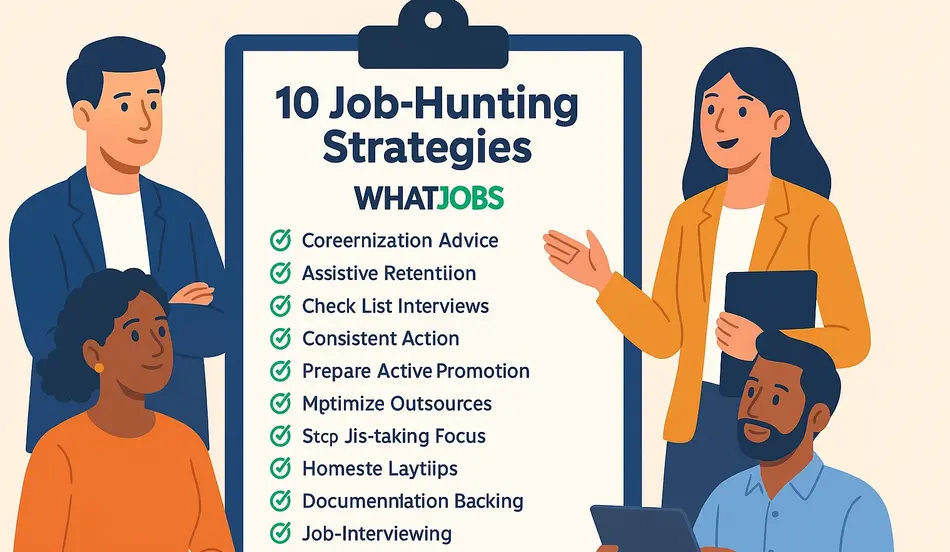Taking a strategic, organized approach to your job search will save you time, reduce stress, and deliver better results. Below, we dive deeper into ten proven job-hunting strategies—complete with concrete examples, templates, and action steps—to help you secure interviews and offers more efficiently.
1. Define Your Target Roles and Industries
Zeroing in on the right roles and sectors prevents scattershot applications and empowers you to speak directly to employers’ needs.
- Map Your Ideal Position
- Exercise: List your top three strengths (e.g., project management, data analysis, stakeholder communication) and match them to common job titles.
- Example: If you excel at data storytelling, target roles like “Business Intelligence Analyst” or “Data Visualization Specialist.”
- Research Growth Sectors
- Consult industry reports (e.g., Gartner, LinkedIn Economic Graph) to identify fields expanding year over year.
- Use WhatJobs’ Trends Insights to see which sectors—like renewable energy or e-commerce—are ramping up hiring.
- Create a Target List
- Bookmark 20–30 open roles on WhatJobs that align with your criteria.
- Update weekly: remove filled roles, add fresh listings.
- Set Priorities
- Rank roles by “fit” score: 1–2 = dream jobs, 3–5 = solid matches, 6–10 = stretch opportunities.
- Focus 70% of efforts on your top-5 “dream” roles.
2. Optimize Your Resume for Applicant Tracking Systems (ATS)
ATS-friendly resumes ensure your application makes it into human hands.
- Keyword Matching
- Action: For each role, highlight 5–7 core skills or requirements from the job posting.
- Template: sqlCopyEdit
Relevant Skills: Python · SQL · Tableau · Data Modeling · Agile Methodologies
- Use Simple Formatting
- Stick to a single-column layout.
- Use classic fonts like Arial or Calibri at 10–12 pt.
- Avoid headers/footers, text boxes, or embedded images.
- Quantify Achievements
- Always lead with results:
- ✔ “Reduced monthly operational costs by 12% ($50K+) through process automation.”
- ✔ “Managed a cross-functional team of 8 to deliver 3 product releases on schedule.”
- Always lead with results:
- Proofread and Validate
- Upload your draft to an ATS simulator (e.g., Jobscan) to see how well it parses.
- Tweak headings and bullet language until the simulator flags minimal “unrecognized content.”
3. Customize Your Cover Letter Every Time
A personalized cover letter shows genuine interest and thoughtfulness.
- Personalized Salutation
- Research the hiring manager on LinkedIn or company “Team” pages.
- Use: “Dear Ms. Patel,” instead of generic “To whom it may concern.”
- Tell Your Story
- Structure:
- Hook (1 sentence): Why you care about their mission (e.g., “As a longtime admirer of GreenTech’s commitment to sustainable innovation…”).
- Value Proposition: Two–three bullet points showing how your experience directly addresses their needs.
- Fit Paragraph: “What excites me most is…” linking your passions to their 2025 objectives.
- Structure:
- Strong Call-to-Action
- End with: “I welcome the chance to discuss how my background in data architecture can help streamline your reporting pipeline. Thank you for your time, and I look forward to next steps.”
- Formatting Tips
- Keep to one page.
- Match font and margins to your resume for a cohesive package.
4. Leverage Job Boards Strategically
Job boards are powerful—but only if used smartly.
- Targeted Alerts
- On WhatJobs, set up alerts for combinations of keywords and locations (e.g., “remote digital marketing” + “Europe”).
- Choose daily or weekly frequency to balance recency and overload.
- Niche Boards
- Identify specialized sites:
- Tech: Stack Overflow Jobs, Hacker News “Who’s Hiring?”
- Design: Dribbble, Behance.
- Nonprofits: Idealist, Devex.
- Identify specialized sites:
- Application Rotation
- Method: Batch-apply to 5 top-priority roles per week, rather than every listing.
- Benefit: Focuses your energy and allows thoughtful customization.
- Audit Your Strategy Quarterly
- Analyze which boards yield the most responses.
- Reallocate efforts accordingly.
5. Build and Activate Your Network
Up to 70% of jobs are filled via referral—tap into your network early and often.
- Reconnect Thoughtfully
- Send brief, specific messages: “Hi Jane, hope you’re well! I’m exploring new opportunities in UX design and thought of you. Any advice or contacts you could share?”
- Strategic Networking Events
- Before the Event: Research speakers and attendees, prepare two talking points.
- During: Ask open-ended questions (“What projects are you most excited about this year?”).
- After: Send personalized LinkedIn invites referencing your conversation.
- Give Before You Get
- Share content or intros: “I came across this article on AI ethics and thought it might interest you.”
- People remember requests preceded by genuine help.
- Maintain Relationships
- Schedule quarterly “check-ins” with key contacts.
- Offer updates on your progress and inquire about theirs.
6. Polish Your Online Presence
Your digital footprint can open doors before you even apply.
- LinkedIn Optimization
- Headline: Combine role + area of expertise “Software Engineer | Scalable Cloud Architecture & DevOps”
- About Section:
- 3–4 short paragraphs: your mission, top skills, standout achievements.
- Content Sharing
- Post original insights or project retrospectives.
- Engage with industry leaders by commenting thoughtfully on their posts.
- Profile Consistency
- Ensure your resume, LinkedIn, GitHub, and personal website use the same role descriptions and achievements.
- Remove any unprofessional or off-brand content.
- SEO for Your Name
- Publish a blog post or guest article on your niche—this can rank on search engines when recruiters Google you.
7. Upskill Continuously
Staying current boosts your marketability and shows initiative.
- Identify In-Demand Skills
- Monitor WhatJobs’ Emerging Skills dashboard or LinkedIn’s “Top Skills” report.
- Note recurring technologies (e.g., React, Kubernetes) or methodologies (e.g., Design Thinking).
- Fast-Track Learning
- Enroll in short, project-based courses (e.g., 4-week intensive).
- Complete a capstone that you can showcase on GitHub or in your portfolio.
- Certifications & Badges
- Add them to your resume and LinkedIn under “Licenses & Certifications.”
- Example: “Google Data Analytics Professional Certificate (June 2025).”
- Demonstrate Applied Learning
- Create a mini-project or write a blog post walking through your process and results.
8. Practice Structured Interview Prep
Confidence comes from preparation; preparation comes from structure.
- Compile Core Questions
- Behavioral: “Tell me about a time you faced conflict on a team.”
- Technical: “How would you optimize a SQL query that’s running slowly?”
- STAR Method in Action
- Situation: Brief context.
- Task: Your responsibility.
- Action: Steps you took (focus on your role).
- Result: Quantifiable outcome.
- Mock Interviews
- Use platforms like Pramp or enlist a mentor.
- Record the session, review for filler words, pacing, and clarity.
- Research the Employer
- Examine their latest news, product launches, and annual report.
- Prepare 2–3 thoughtful questions (e.g., “How does your team measure success in the first 90 days?”).
9. Follow Up Thoughtfully
Timely, polite follow-up keeps you top-of-mind without crossing lines.
- Thank-You Email Template pgsqlCopyEdit
Subject: Thank You – [Role] Interview Hi [Interviewer Name], Thank you for the opportunity to discuss the [Role] position today. I enjoyed learning more about [specific project or aspect]. I’m excited about the prospect of contributing my [skill/experience] to [Company] and confident I can deliver [result]. Please let me know if you need any additional information. I look forward to next steps. Best regards, [Your Name] - Status Check-In
- Wait until the timeframe they provided; if none, wait 7–10 business days.
- Keep it short: “I remain very interested in the [Role] and would welcome any updates you can share.”
- Track All Outreach
- Maintain a spreadsheet or WhatJobs’ application tracker with:
- Date applied
- Interview dates
- Follow-up sent
- Responses received
- Maintain a spreadsheet or WhatJobs’ application tracker with:
10. Stay Organized and Resilient
A disciplined approach safeguards your well-being and ensures steady progress.
- Daily Routine
- Morning (1 hr): New applications and alert reviews.
- Afternoon (1 hr): Networking outreach or skill-building.
- Late Day (30 min): Quick review of metrics (responses, interviews booked).
- Weekly Goals
- Set SMART targets:
- “Apply to 7 high-priority roles.”
- “Schedule 3 informational interviews.”
- “Complete one new online module.”
- Set SMART targets:
- Mental Health & Breaks
- Use the Pomodoro Technique: 25 minutes work, 5 minutes rest.
- Schedule two “no-job-search” hours each day for exercise, hobbies, or social time.
- Celebrate Small Wins
- Share milestones—like “First interview of the month”—with friends or mentors.
- Recognizing progress fuels motivation.
Ready to Elevate Your Search?
Implement these expanded job-hunting strategies on WhatJobs today. With a clear focus, tailored applications, and a growth mindset, you’ll transform your job hunt from a shot in the dark into a targeted, high-yield process.
Start applying with these strategies and take control of your career journey now!






